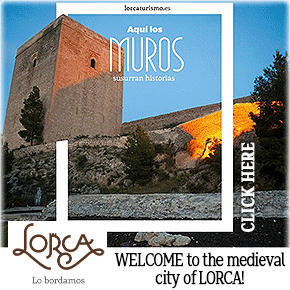- Region
- Águilas
- Alhama de Murcia
- Jumilla
- Lorca
- Los Alcázares
- Mazarrón
- San Javier
-
ALL AREAS & TOWNS
- AREAS
- SOUTH WEST
- MAR MENOR
- MURCIA CITY & CENTRAL
- NORTH & NORTH WEST
- TOWNS
- Abanilla
- Abarán
- Aguilas
- Alamillo
- Alcantarilla
- Aledo
- Alhama de Murcia
- Archena
- Balsicas
- Blanca
- Bolnuevo
- Bullas
- Cañadas del Romero
- Cabo de Palos
- Calasparra
- Camping Bolnuevo
- Campo De Ricote
- Camposol
- Canada De La Lena
- Caravaca de la Cruz
- Cartagena
- Cehegin
- Ceuti
- Cieza
- Condado de Alhama
- Corvera
- Costa Cálida
- Cuevas De Almanzora
- Cuevas de Reyllo
- El Carmoli
- El Mojon
- El Molino (Puerto Lumbreras)
- El Pareton / Cantareros
- El Raso
- El Valle Golf Resort
- Fortuna
- Fuente Alamo
- Hacienda del Alamo Golf Resort
- Hacienda Riquelme Golf Resort
- Isla Plana
- Islas Menores & Mar de Cristal
- Jumilla
- La Azohia
- La Charca
- La Manga Club
- La Manga del Mar Menor
- La Pinilla
- La Puebla
- La Torre
- La Torre Golf Resort
- La Unión
- Las Palas
- Las Ramblas
- Las Ramblas Golf
- Las Torres de Cotillas
- Leiva
- Librilla
- Lo Pagan
- Lo Santiago
- Lorca
- Lorquí
- Los Alcázares
- Los Balcones
- Los Belones
- Los Canovas
- Los Nietos
- Los Perez (Tallante)
- Los Urrutias
- Los Ventorrillos
- Mar De Cristal
- Mar Menor
- Mar Menor Golf Resort
- Mazarrón
- Mazarrón Country Club
- Molina de Segura
- Moratalla
- Mula
- Murcia City
- Murcia Property
- Pareton
- Peraleja Golf Resort
- Perin
- Pilar de la Horadada
- Pinar de Campoverde
- Pinoso
- Playa Honda
- Playa Honda / Playa Paraíso
- Pliego
- Portmán
- Pozo Estrecho
- Puerto de Mazarrón
- Puerto Lumbreras
- Puntas De Calnegre
- Region of Murcia
- Ricote
- Roda
- Roldan
- Roldan and Lo Ferro
- San Javier
- San Pedro del Pinatar
- Santiago de la Ribera
- Sierra Espuña
- Sucina
- Tallante
- Terrazas de la Torre Golf Resort
- Torre Pacheco
- Totana
- What's On Weekly Bulletin
- Yecla


- EDITIONS:
 Spanish News Today
Spanish News Today
 Alicante Today
Alicante Today
 Andalucia Today
Andalucia Today
article_detail
We all know the history of the Gunpowder Plot, but you may not realise that Guy Fawkes learnt all he knew in Spain
The man whose name became synonymous with treason and fireworks learnt his trade on Spanish soil... this is the Spanish connection behind Guy Fawkes and Bonfire Night

Guy Fawkes’ Night. Bonfire Night. Fireworks Night. Call it what you will, the 5th of November is a peculiarly British institution. Every year on November 5, the skies over Britain burst with colour as fireworks light up the night.
Bonfires blaze, sparklers fizz and effigies of a long-dead man named Guy Fawkes go up in flames. Officially, the tradition commemorates the foiling of the Gunpowder Plot of 1605, a failed attempt by a group of English Catholics to blow up the Houses of Parliament and assassinate the Protestant King James I.
“Remember, remember the fifth of November: gunpowder, treason and plot; I know of no reason why the fifth of November should ever be forgot.”
Indeed, Spain’s Valencia region even has its own annual celebration of fireworks where they burn satirical effigies, the ‘Fallas’ festival, which takes place each year in March.
But what is often forgotten about the UK’s Bonfire Night is that Guy Fawkes, the most famous face of the notorious Gunpowder Plot, honed his military skills and knowledge of explosives in Spain.
From York to the Spanish army
Born in York in 1570, Guy Fawkes was raised a Protestant but converted to Catholicism as a young man, influenced by his stepfather, a recusant who opposed the Anglican Church. Like many English Catholics of the time, Fawkes felt alienated under Protestant rule and looked abroad for allies. His journey led him to Spain, then Europe’s great Catholic power.
He left England and joined the Spanish army of King Philip II, fighting against the Protestant Dutch in the Eighty Years’ War. It was during this period that Fawkes adopted the Italianised version of his name, ‘Guido Fawkes’, and developed his expertise in military engineering and explosives, knowledge that would later play a central role in the Gunpowder Plot.
A mission to Valladolid
In 1603, after years of warfare in Flanders, Fawkes travelled to Spain in search of political and military backing for a Catholic rebellion in England. His destination was Valladolid, where King Philip III’s court was temporarily based. The city was not only the centre of royal power at the time but also home to the College of St Alban’s, which trained English Catholic priests in exile.
Fawkes, along with Thomas Wintour, a fellow Brit he met there and who would later become his coconspirator in the Gunpowder Plot, attempted to persuade the Spanish crown to support an uprising against King James I. Although he was reportedly received cordially, his appeals fell on deaf ears. Philip III, under the influence of his chief minister, the Duke of Lerma, was pursuing a policy of peace with England after decades of costly conflict. The Spanish monarchy, wary of fresh entanglements, declined to involve itself directly in English affairs.
Spain’s shadowy role in the conspiracy
And yet, while there is to this day no definitive proof that Spain had any direct hand in financing or planning the Gunpowder Plot, some historians suggest that the country’s sympathy for English Catholics may have extended to covert support.
Fawkes’ links to Spanish military circles and his meetings with high-ranking figures, such as Juan de Velasco, the Constable of Castilla, have fuelled speculation that under-the-table Spanish influence may have played a part.
Whether or not Spain had any involvement, the English authorities certainly suspected it. At a time when Europe was divided along deep religious lines, the idea that the plot might have been encouraged by Catholic powers abroad fitted easily into the Protestant narrative.
And the rest is history
When diplomatic efforts failed, Fawkes returned to England and joined a group of conspirators led by Robert Catesby. Together they hatched a plan to blow up the House of Lords during the State Opening of Parliament. Their goal was to kill the king and much of the Protestant establishment, then install a Catholic monarch in his place.
The familiar story goes that the conspirators rented a cellar beneath Parliament and filled it with 36 barrels of gunpowder. However, their secret was betrayed. In the early hours of November 5, 1605, Guy Fawkes was discovered guarding the explosives. He was arrested, tortured and executed soon after, along with most of his fellow plotters.
Even today, tradition dictates that the cellars of the Palace of Westminster are searched before each State Opening of Parliament, a ritual reminder of the night when treason nearly triumphed.
Ironically, Guy Fawkes’ failure ensured his immortality. His name has become synonymous with rebellion, especially thanks to the use of his likeness in Alan Moore’s V for Vendetta comics and the branding for the Occupy Wall Street movement they later inspired.
Now, Guy Fawkes’s face is an enduring symbol of defiance for modern political movements around the world and for British people, in particular, represents what is quite a fun annual tradition. Yet behind the flames and fireworks lies a lesser-known truth: the knowledge that made Guy Fawkes dangerous was forged not in England, but in Spain.
You may also like to read: These are the rules for using fireworks in Spain that you have to know
Image: National Portrait Gallery
Loading
Sign up for the Spanish News Today Editors Roundup Weekly Bulletin and get an email with all the week’s news straight to your inbox
Special offer: Subscribe now for 25% off (36.95 euros for 48 Bulletins)
OR
you can sign up to our FREE weekly roundup!
Read some of our recent bulletins:
Discount Special Offer subscription:
36.95€ for 48 Editor’s Weekly News Roundup bulletins!
Please CLICK THE BUTTON to subscribe.
(List price 3 months 12 Bulletins)
Read more stories from around Spain:
Contact Spanish News Today: Editorial 966 260 896 /
Office 968 018 268



















